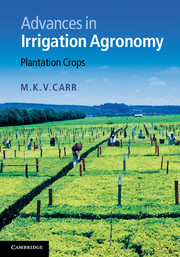5 - Coffee
Published online by Cambridge University Press: 05 May 2012
Summary
Introduction
There are two principal types of coffee grown commercially: Coffea arabica L., commonly known as ‘arabica’ coffee, and Coffea canephora Pierre ex Froehner, commonly known as ‘robusta’ coffee. A third (Coffea liberca Bull ex Hiern) is grown only on a very small scale. The useful product is the bean, a relatively heavy seed that ripens within a sweet red fruit. The seeds, rich in caffeine, form the basis of a beverage widely traded and consumed throughout the world.
Many of the physiological characters of coffee can best be understood by recalling the conditions under which these species evolved, particularly the responses to water. The centre of origin of C. arabica is considered to be the cool, shady environment in the understorey of forests in the Ethiopian highlands. At these latitudes (6–9° N) and altitudes (1600–2000 m) the mean average air temperature is in the range 15–20 °C, the annual rainfall is 1600–2000 mm and there is a single dry season lasting three to four months. Only relatively recently has arabica coffee been grown in open sunny situations (Figure 5.1), including regions closer to the equator where there are two annual dry seasons (Cannell, 1985). According to Van der Vossen (2001, 2005), virtually all current cultivars of C. arabica are descendants of early introductions of coffee from Ethiopia to Arabia (Yemen), where they were subjected to a relatively dry ecosystem without shade for a thousand or more years, before being introduced into Asia and South America around AD 1700 and two centuries later into East Africa.
- Type
- Chapter
- Information
- Advances in Irrigation AgronomyPlantation Crops, pp. 105 - 144Publisher: Cambridge University PressPrint publication year: 2012

